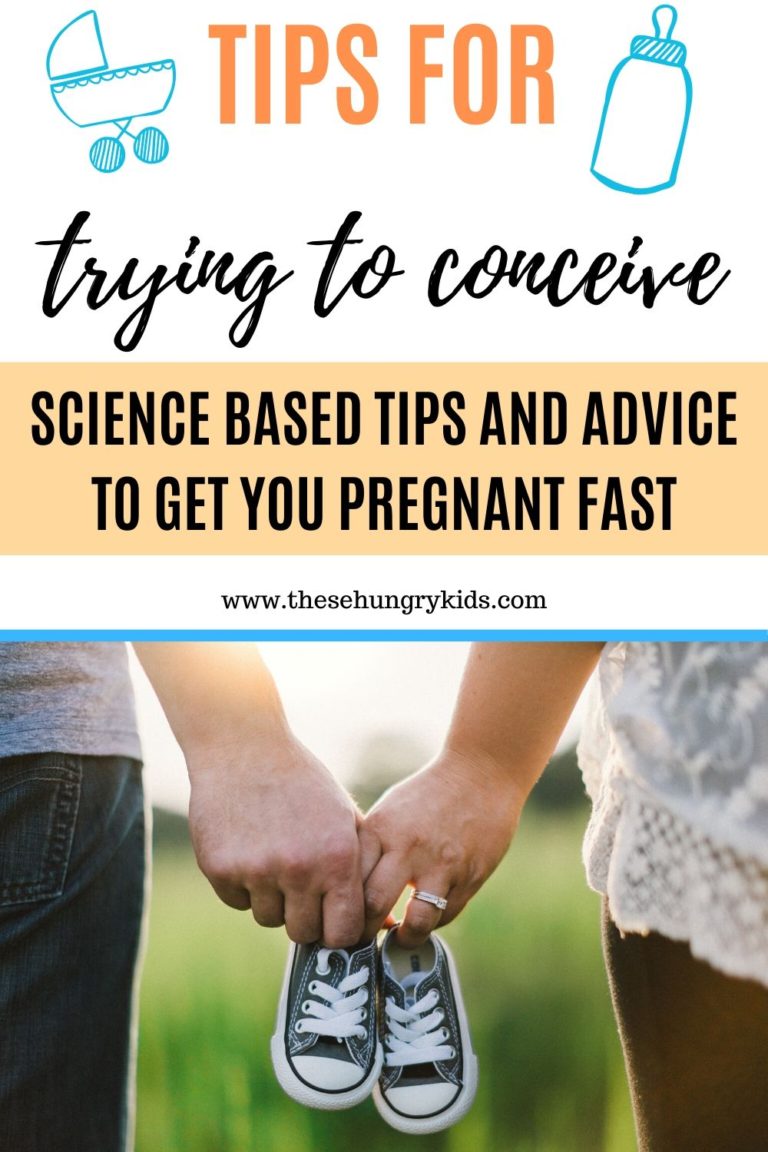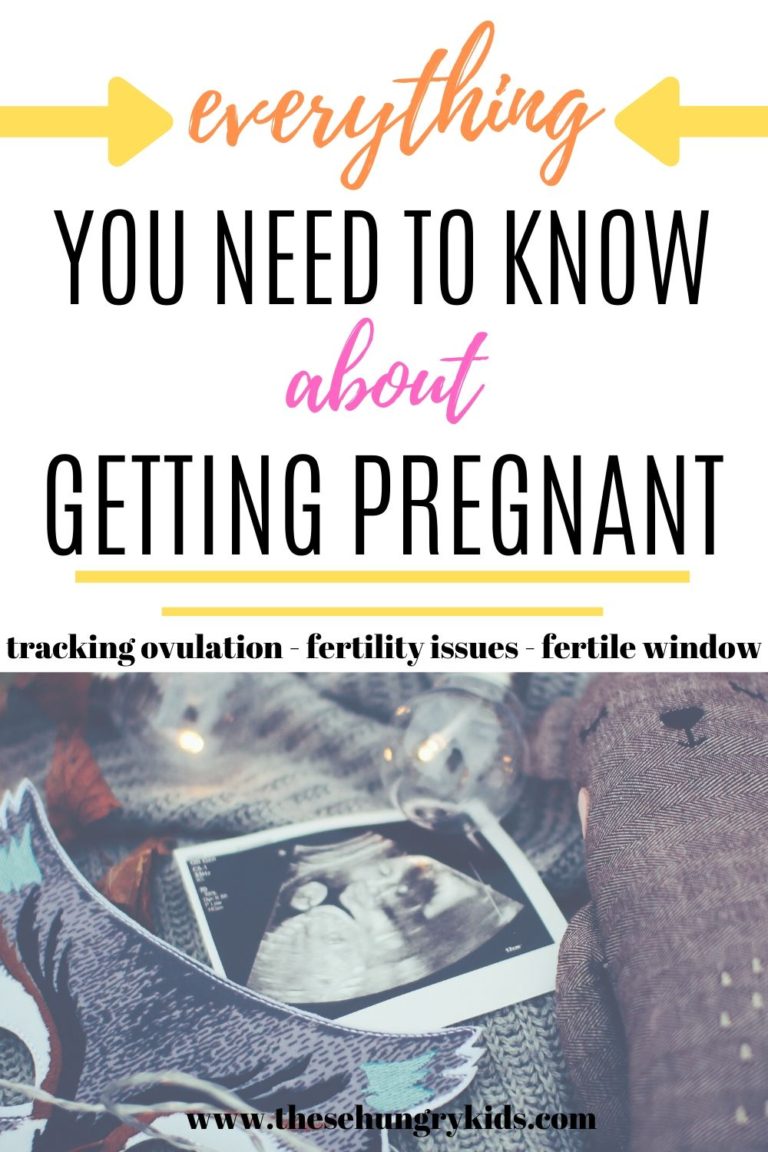Getting pregnant seems like it should be pretty easy, right? While that’s true for some, it can take a long time for some couples to conceive. In this post you’ll get the scoop on everything you need to know to get pregnant fast.
Now, let’s start with the basics. What does it mean to get pregnant?
It means that the woman’s egg is released from one of her ovaries, and it is fertilized by sperm. The cells start multiplying, and the fertilized egg needs to implant into the lining of the uterus. Once this implantation occurs, the cells continue to divide rapidly and eventually form your sweet baby!
It sounds so simple! But the reality is there are many things that need to go exactly right to get pregnant. There are some things that are in your control and other things that are left to fate.
But when all goes right, a sweet little baby is made!
My fertility journey
I went through fertility treatments to conceive my first daughter. I discovered that I had polycystic ovarian syndrome (PCOS) and was not ovulating on my own.
I was fortunate to conceive with fertility medications, and had my first gorgeous daughter in 2017. We just welcomed our third baby girl this November 2020 (yes, three babies in three years!), and the last two babies were conceived completely naturally! You can read the full story of our fertility and pregnancy journeys here.
Getting pregnant
I now work as a labor and delivery nurse and am loving life as a mom to my three cuties.
Sometimes our journey is different than we anticipated. This post is just a guide, and a place for me to share everything I have learned!
I hope that you have the easiest time getting pregnant, but please know that infertility is a very common struggle, and you are absolutely not alone if that is the journey that faces you.
*This post is meant for entertainment purposes only, and any concerns for your health should be directed to your personal medical team. Read my Medical Disclaimer in Terms and Conditions for more information. I always adhere to HIPPA policies, any similarities between this post and your personal story is purely coincidental. This post contains affiliate links, meaning if a purchase is made from the links on this post, I may receive a small compensation at no additional cost to you.

Ovulation
You can only get pregnant when you ovulate.
You can’t get pregnant at any point during your cycle. An egg has to be released for the sperm to fertilize it!
In fact, the window of time that you can get pregnant during is only a few days long.
The days that you can get pregnant is often called your fertile window.
Ovulation is when a woman’s ovary releases an egg. There are two ovaries, but an egg is typically only released from one of them each cycle. In the case of fraternal twins, two eggs are released.
Without getting too technical, the gist of it is: your body’s hormones start to change, and causes a little fluid filled sac called a follicle to build inside of the ovary. When the hormones change again, that follicle releases an egg, which then travels down the fallopian tube.
The egg is ready to be fertilized at that point, and if it isn’t fertilized it disintegrates and your period begins. If it is fertilized and implants into the uterine lining, your body starts producing HCG, which is the hormone that home pregnancy tests check for.
This whole process typically begins 2 weeks before your period is due, but there are several ways to determine if you are ovulating.
Related: No Pregnancy Symptoms After IUI? Here’s Why You Shouldn’t Panic.
Ways to Determine Ovulation
To get pregnant faster, you need to know exactly when you are ovulating and not just guess!
Then you need to time your intercourse around when you are ovulating to give the sperm the best chance at reaching the egg.
Home Ovulation Predictor Kits
Taken just like a pregnancy test, there are tons of home tests you can try to predict your ovulation.
The worst thing about the home tests is that they can be very hard to read. You are waiting until the line from the test is as dark or darker than the control line, and it can be a little difficult to tell.
Also, some women claim the line is never as dark as the control line, leaving them feeling unclear of their ovulation.
While it can be a little difficult to read these home ovulation predictor kits, hopefully you can make an educated guess about when exactly you are ovulating.

Cervical Mucus
Tracking your cervical mucus can be a very effective way of determining ovulation. It may seem kind of yucky, but feeling and assessing your discharge can be a good indicator of ovulation.
According to this article from Verywell Family:
- Not ovulating: dry and sticky fluid
- Ovulation is close: wet and watery fluid
- Ovulation is coming: creamy mucus
- Ovulation is happening: very wet and stretchy mucus that resembles egg whites
If you are trying to get pregnant, you should start having intercourse when the mucus is creamy and turning to egg whites.
Sperm can live up to 5 days, so there is a great chance of conceiving if you have intercourse just before ovulation as well.

Cervical Position
This can be sort of difficult and kind of invasive to check. Basically it involves performing really good hand hygiene, and inserting your fingers into your vagina to see where your cervix is at.
Your cervix is essentially the door to your uterus. It’s usually closed (or at least mostly closed) until you are in labor and giving birth (when they say you’re 10 centimeters dilated, they’re talking about your cervix!)
If you’re close to ovulating, the cervix will be high and soft. If you are not close to ovulating, it will be low and firm.
You will probably have to check many times throughout a few cycles to really learn the difference in your cervical position. It’s not a perfect science by any means, but it can be helpful to know when looking at the full picture of your cervical mucus, ovulation predictor kit, and basal body temperature (read below).
Basal Body Temperature
This takes a lot of work, but it has been successful for many. Your basal body temperature (BBT) is your temperature when you are fully at rest. There are many tracking charts you can find online, but you have to be very consistent with this method.
Guidelines for BBT testing:
- Use the same thermometer through the whole cycle
- Take the temperature at the same time every morning
- The temperature must be taken before you get up and move around, ideally within 1-2 minutes of waking
- Must check temperature every day
- Must get at least 3-4 hours of sleep before testing.
There is some debate on which kind of thermometer is best. There are special basal body temperature thermometers that go to two decimal points (this one even connects to its own tracking app) but many experts say a normal home thermometer is fine.
For more info on basal body temp testing, check out this article.
Ava Bracelet
These bracelets have been all the rage lately, and I keep hearing them talked.
In fact, many celebrities such as Catherine Lowe and Jade Tolbert (shoutout to my Bachelor fans out there!) have talked about how their Ava bracelet has helped them conceive their babies.
As a labor nurse, I totally geek out over this sort of thing. This technology is very fascinating to me, and I’m excited to see how it continues to develop.
Ava is a bracelet that you wear to bed each night and sync with an app in the morning. It gives insights into your overall health, as well as your most fertile days. It gives you your five most fertile days based off of:
- Temperature
- Resting pulse rate
- Heart rate variability
- Breathing rate
- Perfusion
Ava is great for women with a regular cycle who want to get pregnant fast. It even works if you have endometriosis or are breastfeeding. It can help take the guess work out of ovulation.
I have to disclose: I have never used Ava due to my PCOS. It is important to note that Ava will not work for you if you have a condition that interrupts ovulation, such as polycystic ovarian syndrome. This is because people with PCOS (or other ovulation problems) have hormone levels that don’t necessarily correspond with ovulation. Therefore, Ava may detect a fertile window when there is in fact no egg released.
If you are concerned you may have an ovulation problem, speak with your OB/GYN or midwife and request an evaluation before purchasing.
Ava will donate 20% of every sale to women’s health research, which is just one of the many reasons this company is awesome.
The con? It’s a bit pricey. The basic package costs $299, but they do offer a payment plan and will give you $20 to refer to a friend. For an extra $100 they will guarantee pregnancy within one year.
You can also use it while you’re pregnant to track your overall health and sleep. It’s not just a “use until you’re pregnant and then throw it away” kind of thing. It’s an investment into your health.
You can learn more about the Ava bracelet here.

Things that affect your ability to get pregnant
Ovulation Issues
There are several conditions that can affect ovulation in a woman. These include:
- Polycystic ovarian syndrome
- Mentioned above, PCOS is a common cause of infertility. PCOS causes a hormonal imbalance and problems with metabolism. Symptoms include an irregular menstrual cycle, excessive hair growth, acne, weight gain or difficulty losing weight, skin discoloration, and skin tags. If you are concerned you may have PCOS, talk to your physician. It is not difficult to diagnose, and it can be treated.
- Because of the hormone changes in people with PCOS, traditional methods of tracking ovulation are usually inaccurate. Someone with PCOS may get a positive on ovulation tests without ovulation.
- Endometriosis
- Endometriosis may affect ovulation if it becomes severe. It occurs when tissue grows outside of the uterus and sometimes onto the ovaries, fallopian tubes, or connective tissues. Symptoms include pain in the abdomen, pelvic area, or intestinal pain, bleeding and spotting between periods, digestive issues, and infertility. Speak to your doctor if you think you could have endometriosis.
- Pelvic Inflammatory disease
- PID is an infection of a woman’s reproductive organs that can cause issues with fertility. It is usually caused by a sexually transmitted disease, and can cause many reproductive issues if not treated properly. Symptoms include fevers, pain, vaginal discharge with or without a foul odor, painful sex, irregular menstrual cycles, and difficulty urinating. PID can be diagnosed through a pelvic exam and testing for sexually transmitted infections. It is often treated with antibiotics.
If you are concerned you are not ovulating, speak to your OB/GYN or midwife about your concerns. They may refer you to a reproductive specialist, or they may be willing to track your ovulation themselves. This will require some monitoring throughout your cycle, but it is not difficult to find out if you are ovulating with blood tests and ultrasounds.
For more information regarding these health conditions, check out this article from the Office on Women’s Health.
Male Infertility
Sometimes the inability to get pregnant is due to male infertility.
Semen quality is a crucial part of conceiving, and there are many components to consider, including:
- The number of sperm
- Overall health of the sperm
- The shape of the sperm
- The ability of the sperm to move
There may also be issues with ejaculation, ability to produce sperm, and the ability of the sperm to move out of the testicles.
As a labor nurse and a woman who has experienced infertility, I know a good deal about women’s reproductive health. However, I am not so fresh on male factor infertility. For that reason, I’m going to direct you to this site to learn more.

A few extra tips to help you get pregnant fast:
- Preseed is a special type of lubricant that can help you get pregnant. This lubricant won’t harm sperm (other lubes can actually kill sperm!) and mimics vaginal fluid. It was recommended to me by the fertility clinic I went to when trying to conceive my first.
- Sex every other day during your ovulation window is plenty – at most sex once per day is enough! The sperm counts can actually be lower with sex too frequently, so don’t put too much pressure on yourself
- Start taking prenatals while you’re trying to conceive, and continue them after the pregnancy if you plan to breastfeed! It’s a good idea to increase folic acid levels early, and there’s no harm in extra vitamins.
- Eat a healthy diet with whole foods. If you are overweight, losing weight may help your ability to conceive.
- Don’t wait until you’re pregnant to quit smoking — it can harm your ability to get pregnant and can hurt the baby. That includes both cigarettes and marijuana.
Smoking marijuana leads to a higher chance of miscarriage — it’s a good idea to avoid it when trying to conceive! And did you know that the men’s use of marijuana can DOUBLE the woman’s risk of miscarriage? Check out this post from March of Dimes to read why you should avoid marijuana altogether during pregnancy and breastfeeding.
Trying to conceive can be either very stressful, or very fun and exciting! Everyone wants to get pregnant fast, but remember, in the best case scenario, under perfect conditions, there is only a 15-25% chance of getting pregnant each month. It can take some time, and that’s perfectly normal!
Generally, the recommendation is to seek the help of an OB/GYN or reproductive endocrinologist after 1 year of trying with no pregnancies.
Good luck, and keep it fun!

Hey, love! Are we friends, yet??
Follow me on Facebook, Instagram and Pinterest to stay in touch with the best and greatest from this blog and other blogs from across the web!
Better yet – subscribe using the form below to get emails! I promise I don’t spam (I truly don’t have the energy to spam you with emails) and you can unsubscribe at any point. I only email the important stuff!
Thanks for checking out my blog! I love reading comments, too, so don’t hesitate to tell me what you think!


This is great stuff!!
I’m so glad you liked it! Xo
I was married at 32 and immediately tried to get pregnant. When I was unable to conceive I had blood tests for fertility and was told that I had an FSH (follicle stimulating hormone) of 54 and would not be able to have children. Even though the doctors knew that I had been diagnosed with Hashimoto’s thyroiditis since age 25, no one bothered to check my thyroid levels. my TSH was measured at .001. My Synthroid dosage was lowered. a friend advise me to contact a spiritualist who help with fertility with his medicine, i collected his contact and explain my situation to him he prepared for me a herbal medicine which i took as describe by him. became pregnant very quickly, I had a successful pregnancy. I have my baby august 2017. to get pregnant at age 35 with my 2nd child in september 2019, thank you
I’m so happy for you, Brittany! Thank you for sharing your story.